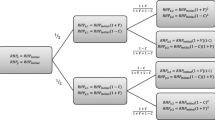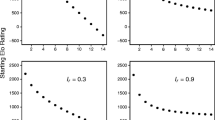Abstract
Animals that live in groups commonly form themselves into dominance hierarchies which are used to allocate important resources such as access to mating opportunities and food. In this paper, we develop a model of dominance hierarchy formation based upon the concept of winner and loser effects using a simulation-based model and consider the linearity of our hierarchy using existing and new statistical measures. Two models are analysed: when each individual in a group does not know the real ability of their opponents to win a fight and when they can estimate their opponents’ ability every time they fight. This estimation may be accurate or fall within an error bound. For both models, we investigate if we can achieve hierarchy linearity, and if so, when it is established. We are particularly interested in the question of how many fights are necessary to establish a dominance hierarchy.










Similar content being viewed by others
References
Addison WE, Simmel EC (1980) The relationship between dominance and leadership in a flock of ewes. Bull Psychonom Soc 15(5):303–305
Alcock J (1993) Animal behavior: an evolutionary approach. Sinauer Associates, Massachusetts
Allee WC (1951) Cooperation among animals, with human implications: a revised and amplified edition of the social life of animals. Henry Schuman, New York
Appleby MC (1983) The probability of linearity in hierarchies. Anim Behav 31(2):600–608
Bakker TH, Bruijn E, Sevenster P (1989) Asymmetrical effects of prior winning and losing on dominance in sticklebacks (Gasterosteus aculeatus). Ethology 82(3):224–229
Balakrishnan R, Ranganathan K (2012) A textbook of graph theory. Springer, Berlin
Beacham JL (1988) The relative importance of body size and aggressive experience as determinants of dominance in pumpkinseed sunfish, lepomis gibbosus. Anim Behav 36(2):621–623
Beacham JL (2003) Models of dominance hierarchy formation: effects of prior experience and intrinsic traits. Behaviour 140(10):1275–1304
Bergman DA, Kozlowski CP, McIntyre JC, Huber R, Daws AG (2003) Temporal dynamics and communication of winner-effects in the crayfish, orconectes rusticus. Behaviour 140:805–825
Bonabeau E, Theraulaz G, Deneubourg JL (1999) Dominance orders in animal societies: the self-organization hypothesis revisited. Bull Math Biol 61(4):727–757
Broom M (2002) A unified model of dominance hierarchy formation and maintenance. J Theor Biol 219(1):63–72
Broom M, Cannings C (2002) Modelling dominance hierarchy formation as a multi-player game. J Theor Biol 219(3):397–413
Brown JL, Brown ER, Sedransk J, Ritter SH (1997) Dominance, age, and reproductive success in a complex society: a long-term study of the mexican jay. Auk 114:279–286
de Villiers MS, Richardson PRK, van Jaarsveld AS (2003) Patterns of coalition formation and spatial association in a social carnivore, the african wild dog (Lycaon pictus). J Zool 260(04):377–389
de Vries H (1995) An improved test of linearity in dominance hierarchies containing unknown or tied relationships. Anim Behav 50(5):1375–1389
Dugatkin LA (1995) Formalizing allee’s ideas on dominance hierarchies: an intrademic selection model. Am Nat 146:154–160
Dugatkin LA (1997) Winner and loser effects and the structure of dominance hierarchies. Behav Ecol 8(6):583–587
Dugatkin LA, Dugatkin AD (2007) Extrinsic effects, estimating opponents’ RHP, and the structure of dominance hierarchies. Biol Lett 3(6):614–616
Early R, Dugatkin LA (2010) Behavior in groups. In: Westneat D, Fox C (eds) Evolutionary Behavioral Ecology. Oxford University Press, pp 285–307
Fero K, Simon JL, Jourdie V, Moore PA (2007) Consequences of social dominance on crayfish resource use. Behaviour 144:61–82
Frank LG (1986) Social organization of the spotted hyaena crocuta crocuta. II. Dominance and reproduction. Anim Behav 34(5):1510–1527
Goessmann C, Hemelrijk C, Huber R (2000) The formation and maintenance of crayfish hierarchies: behavioral and self-structuring properties. Behav Ecol Sociobiol 48(6):418–428
Hand JL (1986) Resolution of social conflicts: dominance, egalitarianism, spheres of dominance, and game theory. Q Rev Biol 61:201–220
Hemelrijk CK (2000) Towards the integration of social dominance and spatial structure. Anim Behav 59(5):1035–1048
Hoglund J, Alatalo RV (1995) Leks. Princeton University Press, Princeton
Hsu Y, Earley RL, Wolf LL (2006) Modulation of aggressive behaviour by fighting experience: mechanisms and contest outcomes. Biol Rev 81(1):33–74
Hsu Y, Lee IH, Lu CK (2009) Prior contest information: mechanisms underlying winner and loser effects. Behav Ecol Sociobiol 63(9):1247–1257
Kendall MG (1962) Rank correlation methods. Griffin, London
Klopfer PH (1973) Behavioral aspects of ecology. Prentice Hall, Englewood Cliffs
Kokko H, Lindström J, Alatalo RV, Rintamäki PT (1998) Queuing for territory positions in the lekking black grouse (Tetrao tetrix). Behav Ecol 9(4):376–383
Landau HG (1951a) On dominance relations and the structure of animal societies: I. effect of inherent characteristics. Bull Math Biophys 13(1):1–19
Landau HG (1951b) On dominance relations and the structure of animal societies: II. Some effects of possible social factors. Bull Math Biophys 13(4):245–262
Lindquist WB, Chase ID (2009) Data-based analysis of winner-loser models of hierarchy formation in animals. Bull Math Biol 71(3):556–584
Marsden HM (1968) Agonistic behaviour of young rhesus monkeys after changes induced in social rank of their mothers. Anim Behav 16(1):38–44
McDonald DB, Shizuka D (2013) Comparative transitive and temporal orderliness in dominance networks. Behav Ecol 24:511–520
Mesterton-Gibbons M, Dugatkin LA (1995) Toward a theory of dominance hierarchies: effects of assessment, group size, and variation in fighting ability. Behav Ecol 6(4):416–423
Molet M, Van Baalen M, Monnin T (2005) Dominance hierarchies reduce the number of hopeful reproductives in polygynous queenless ants. Insectes Soc 52(3):247–256
Monnin T, Peeters C (1999) Dominance hierarchy and reproductive conflicts among subordinates in a monogynous queenless ant. Behav Ecol 10(3):323–332
Parker GA (1974) Assessment strategy and the evolution of fighting behaviour. J Theor Biol 47(1):223–243
Rutte C, Taborsky M, Brinkhof MWG (2006) What sets the odds of winning and losing? Trends Ecol Evol 21(1):16–21
Schjelderup-Ebbe T (1922) Beiträge zur sozialpsychologie des haushuhns. Z Psychol
Schmid F, Schmidt A (2006) Nonparametric estimation of the coefficient of overlapping-theory and empirical application. Comput Stat Data Anal 50(6):1583–1596
Schuett GW (1997) Body size and agonistic experience affect dominance and mating success in male copperheads. Anim Behav 54(1):213–224
Shimoji H, Abe MS, Tsuji K, Masuda N (2014) Global network structure of dominance hierarchy of ant workers. J R Soc Interface 11(99):20140599
Shizuka D, McDonald DB (2012) A social network perspective on measurements of dominance hierarchies. Anim Behav 83(4):925–934
Silk JB, Alberts SC, Altmann J (2004) Patterns of coalition formation by adult female baboons in Amboseli, Kenya. Anim Behav 67(3):573–582
Wilson EO (1971) The insect societies. Harvard University Press, Cambridge
Author information
Authors and Affiliations
Corresponding author
Rights and permissions
About this article
Cite this article
Kura, K., Broom, M. & Kandler, A. Modelling Dominance Hierarchies Under Winner and Loser Effects. Bull Math Biol 77, 927–952 (2015). https://doi.org/10.1007/s11538-015-0070-z
Received:
Accepted:
Published:
Issue Date:
DOI: https://doi.org/10.1007/s11538-015-0070-z




